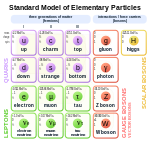Great Unification Event (physics)
In physics, Great Unification Events refers to three notable advancements in theory made throughout history. The first event was realized by Isaac Newton when he unified celestial and terrestrial mechanics[1][2]. The second by James Maxwell, when his equations unified electricity and magnetism.[3][4][5][6] Lastly, the third was realized by Albert Einstein when he unified space and time.
Speculation on Future Unification Events[edit]
Outside of postulations of a final unification event. Possible next discrete unification events include.
- Quantum and Classical Mechanics
- Dark and Classical Matter
- Fundamental Forces and Elementary Particles[7]
- Gravity and the Standard Model[8]
- Spacetime and Matter[9]
- Spacetime and Entropy
References[edit]
- ↑ "Newton: combining celestial and terrestrial mechanics – Matthew van Eerde's web log". Retrieved 2018-09-15.
- ↑ "Newton's Apple". Retrieved 2018-09-15.
- ↑ Nahin, P.J. (1992). "Maxwell's grand unification". Spectrum, IEEE. 29 (3): 45. doi:10.1109/6.123329.
- ↑ "Unifying physics and technology in light of Maxwell's equations | Royal Society". Retrieved 2018-09-15.
- ↑ "Johannes Kepler and The Magnetic Unification of Terrestrial and Cosmic Physics | Harry Ricker III". Retrieved 2018-09-15.
- ↑ Sahoo, S (2012). "Unification after 150 years". arXiv:1210.0154 [physics.gen-ph].
- ↑ "GUTs: The Unification of Forces – College Physics". Retrieved 2018-09-15.
- ↑ "The Unification of Physics | Fritjof Capra". Retrieved 2018-09-15.
- ↑ Chen, Zeng-Bing (2014). "An informationally-complete unification of quantum spacetime and matter". arXiv:1412.3662 [gr-qc].
{Physics}
This article "Great Unification Event (physics)" is from Wikipedia. The list of its authors can be seen in its historical and/or the page Edithistory:Great Unification Event (physics). Articles copied from Draft Namespace on Wikipedia could be seen on the Draft Namespace of Wikipedia and not main one.


